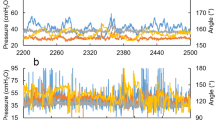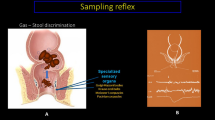Abstract
We compared balloon expulsion, defecography, colonic transit times, anal manometry, and electromyography in 21 patients with severe constipation. Defecography demonstrated nonrelaxation of the sphincter during straining in all patients. Only 12 patients were unable to expel a balloon. Colonic transit was normal (five) or showed rectosigmoid delay (seven). All 12 patients were offered biofeedback. The nine patients able to expel a balloon had normal colonic transit (six) or colonic inertia (two). Rectosigmoid delay was due to severe intussusception in one patient. Anal manometry and pudendal nerve latencies revealed no difference between those who could and those who could not expel a balloon. Balloon expulsion seems to be a more reliable way to diagnose pelvic floor outlet obstruction due to nonrelaxation of the puborectalis muscle. Nonrelaxation of the sphincter on defecography should be correlated with balloon expulsion and colonic transit studies.
Similar content being viewed by others
References
Roe AM, Bartolo DC, Mortensen NJ. Diagnosis and surgical management of intractable constipation. Br J Surg 1986;73:854–6l.
Lennard-Jones JE. Constipation: pathophysiology, clinical features and treatment. In: Henry MM, Swash M, eds. Coloproctology and the pelvic floor. London: Butterworths, 1985:350–75.
Kuijpers HC, Schreve RH, ten Cate Hoedemakers H. Diagnosis of functional disorders of defecation causing the solitary rectal ulcer syndrome. Dis Colon Rectum 1986;29:126–9.
Preston DM, Lennard-Jones JE. Severe chronic constipation of young women: ‘idiopathic slow transit constipation.’ Gut 1986;27:41–8.
Preston DM, Lennard-Jones JE. Anismus in chronic constipation. Dig Dis Sci 1985;30:413–8.
Sonnenberg A, Koch TR. Epidemiology of constipation in the United States. Dis Colon Rectum 1989;32:1–8.
Mishalany HG, Woolley MM. Postoperative functional and manometric evaluation of patients with Hirschsprung's disease. J Pediatr Surg 1987;22:443–6.
Keighley MR, Shouler P. Clinical and manometric features of the solitary rectal ulcer syndrome. Dis Colon Rectum 1984;27:507–12.
Turnbull GK, Lennard-Jones JE, Bartram CI. Failure of rectal expulsion as a cause of constipation: why fibre and laxatives sometimes fail. Lancet 1986;1:767–9.
Kuijpers HC, Bleijenberg G. The spastic pelvic floor syndrome: a cause of constipation. Dis Colon Rectum 1985;28:669–72.
Dolk A, Brodèn G, Holmström B, Johansson C, Nilsson BY. Slow transit of the colon associated with severe constipation after the Ripstein operation: a clinical and physiologic study. Dis Colon Rectum 1990;33:786–90.
Bleijenberg G, Küijpers HC. Treatment of the spastic pelvic floor syndrome with biofeedback. Dis Colon Rectum 1987;30:108–11.
Yoshioka K, Keighley MR. Anorectal myectomy for outlet obstruction. Br J Surg 1987;74:373–6.
Martelli H, Devroede G, Arhan P, Duguay C. Mechanisms of idiopathic constipation: outlet obstruction. Gastroenterology 1978;75:623–31.
Barnes PR, Hawley PR, Preston DM, Lennard-Jones JE. Experience of posterior division of the puborectalis muscle in the management of chronic constipation. Br J Surg 1985;72:475–7.
Billingham RP, Isler JT, Friend WG, Hostetler J. Treatment of levator syndrome using high-voltage electrogalvanic stimulation. Dis Colon Rectum 1987;30:584–7.
Read NW, Timms JM, Barfield LJ, Donnelly TC, Bannister JJ. Impairment of defecation in young women with severe constipation. Gastroenterology 1986;90:53–60.
Jones PN, Lubowski DZ, Swash M, Henry MM. Is paradoxical contraction of puborectalis muscle of functional importance? Dis Colon Rectum 1987;30:667–70.
Preston DM, Lennard-Jones JE, Thomas BM. The balloon proctogram. Br J Surg 1984;71:29–32.
Kiff ES, Swash M. Slowed conduction in the pudendal nerves in idiopathic (neurogenic) faecal incontinence. Br J Surg 1987;71:614–6.
Hinton JM, Lennard-Jones JE, Young AC. A new method for studying gut transit times using radioopaque markers. Gut 1969;10:842–7.
Hoffman MJ, Kodner IJ, Fry RD. Internal intussusception of rectum: diagnosis and surgical management. Dis Colon Rectum 1984;27:435–41.
Lubowski DZ, Swash M, Nicholls RJ, Henry MM. Increase in pudendal nerve terminal motor latency with defaecation straining. Br J Surg 1988;75:1095–7.
Fleshman JW, Dreznik Z, Meyer K, Fry RD, Carney R, Kodner IJ. Outpatient protocol for biofeedback therapy of pelvic floor outlet obstruction. Dis Colon Rectum 1992;35:1–70.
Author information
Authors and Affiliations
Additional information
Read at the meeting of The American Society of Colon and Rectal Surgeons, St. Louis, Missouri, April 29 to May 4, 1990.
About this article
Cite this article
Fleshman, J.W., Dreznik, Z., Cohen, E. et al. Balloon expulsion test facilitates diagnosis of pelvic floor outlet obstruction due to nonrelaxing puborectalis muscle. Dis Colon Rectum 35, 1019–1025 (1992). https://doi.org/10.1007/BF02252990
Issue Date:
DOI: https://doi.org/10.1007/BF02252990




